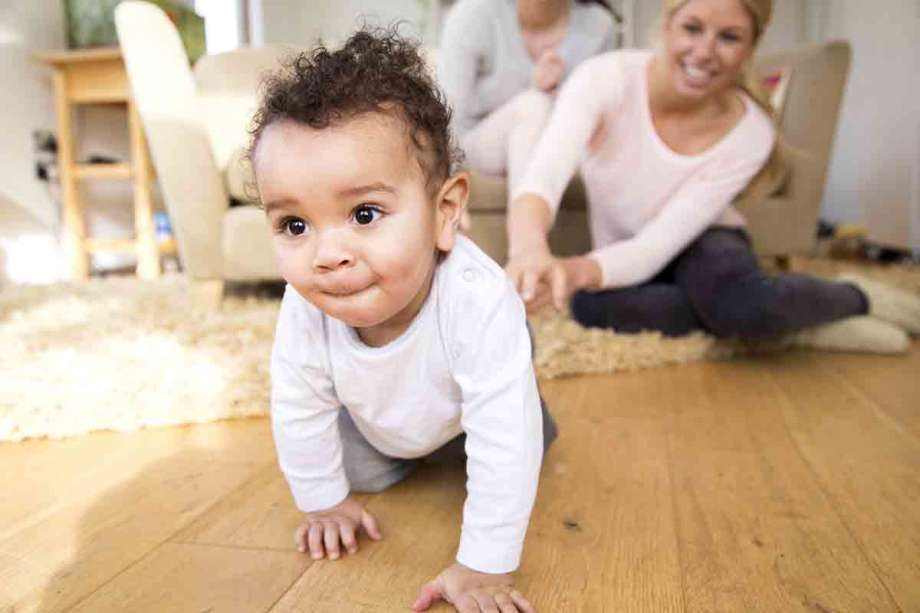When Do Babies Start Crawling?

It seems like infants learn something new every day, and it’s pretty magical to watch baby development. At some point after learning to roll over and get into the sitting position, your little one will learn to crawl.
Crawling changes everything because once your baby learns it, they are mobile. Suddenly you have to keep a tight watch on them and make sure that your living space is baby-proof.
Related: How to Keep Your Crawling Baby Safe
What Age Do Babies Crawl?
According to The American Academy of Pediatrics, babies generally crawl for the first time somewhere around the age of 8 to 12 months old. All babies learn at their own pace, so some babies will crawl sooner than this, and some may take longer. Babies with developmental delays may enter the crawling stage later.
If your baby has reached their first birthday and has not crawled or you have concerns about when they should be crawling, always reach out to your pediatrician.
What Milestones Come Before Crawling?

Baby development occurs on a continuum. Although babies crawl for the first time at different ages, they will generally meet the same developmental milestones in the same order.
Gross Motor Skill Baby Milestones in the First Year of Life:
- Lifting the head in tummy time (around 3 months old)
- Rolling from tummy to back and vice versa (around 4 months old)
- Sitting up (around 6 months old)
- Scooting (not all babies will do this)
- Crawling (around 8-9 months old)
- Standing (around 9-10 months old)
- Walking (around a year old to a year and a half)
Baby Crawling Styles

Just like every baby is different, there are also different types of crawling.
- The Bear Crawl: The baby moves up on their hands and feet with straight limbs.
- The Classic Crawl: What you’d probably picture—hands and knees.
- The Commando Crawl (also called the belly crawl): This one is more of a creep than a crawl. The baby pulls themselves along on their belly. Commando crawling may begin at an earlier age.
- The Crab Crawl: One of the strangest-looking crawls, one leg is bent while the other is straight, pushing the baby along sideways.
- The Scoot: Scooting is a crawling alternative. In the sitting position, babies use their hands to help them scoot along. When babies learn to bottom scoot, they have achieved the goal of moving from one place to another. For this reason, they may not crawl until later on, or they may even skip crawling completely and walk next.
How to Encourage My Baby to Crawl
Babies’ physical development is a natural process. There is no need to rush you child, but you can provide opportunities for them to practice skills that will support their locomotion.
From an early age, make supervised tummy time a part of your daily routine. This strengthens your baby’s core muscles, preparing them for future motor skills.
Fun tip: If you want to workout but you don’t have time because you’re busy taking care of your baby, use your infant’s tummy time to get in some push-ups of your own!
When your baby starts reaching for objects, you can place a favorite toy just out of your baby’s reach. This will encourage them to move their body forward.
As your baby is able to reach the toy, you can move it a little further from them. There will be a point where they can crawl just a few paces and then flop down. At that point, use a toy that moves like a rolling drum to motivate them to keep going. You can also move the toy yourself.
Safety Precautions for Crawlers

Once you have a crawler, it’s important to baby-proof your home and make sure that your little one is supervised. Crawlers will put anything in their mouths and it’s only a matter of time before they are pulling up on the edge of the coffee table and reaching for everything up there too.
Safety Tips:
- Anchor all large furniture to the wall. Babies will commonly try to climb or hold on to things like bookcases or cabinets that are apt to tip and may cause serious injury or death.
- Put gates at the top and bottom of all staircases, even if they also have doors there. Babies may figure out how to climb up the stairs from the bottom and can fall back down.
- Never let your baby play near bodies of water without active supervision by a responsible adult. Drowning can happen in seconds and it may not be immediately apparent that it is happening. Even small amounts of water, such as water in a bucket, can be a drowning hazard.
Crawling is a step in child development that generally starts around 8 to 12 months old. Some babies may crawl earlier or later, and they all learn at their own pace. A few babies who bottom-scoot will skip crawling altogether. If you have any questions or concerns about when your baby will crawl, reach out to your pediatrician.

